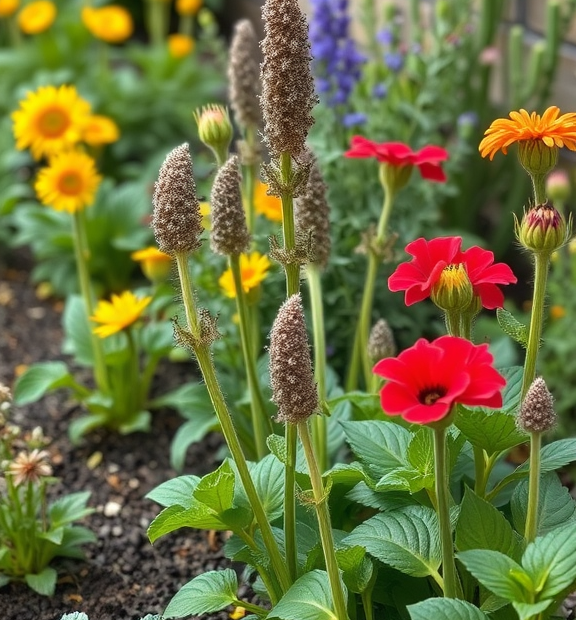The Benefits of Companion Planting for a Thriving Garden
Companion planting is an age-old technique that many gardeners use to enhance plant growth and increase garden yields. By strategically placing different plants next to each other, you can create a thriving garden ecosystem. This approach not only maximizes space but also supports the health of your plants and the environment.
Enhanced Growth and Yield
One of the main advantages of companion planting is improved growth rates and yields. Certain plants have a symbiotic relationship, where one plant helps another thrive. For instance, tomatoes and basil are a classic pairing. Basil can help repel pests that typically harm tomatoes while enhancing their flavor. This combination fosters a vigorous growth environment, often resulting in a more abundant harvest.
Pest Control
Natural pest control is a powerful benefit of companion planting. When you plant certain flowers alongside vegetables, you can attract beneficial insects that prey on harmful pests. Here are some examples:
- Marigolds: These cheerful flowers can deter nematodes, which harm root systems.
- Nasturtiums: They attract aphids, keeping them away from your main crops.
- Lavender: Not only does it smell great, but it also repels moths and fleas.
By incorporating these plants into your garden, you can help reduce chemical use while maintaining a healthy atmosphere for your crops.
Soil Improvement
Companion planting can significantly improve soil quality. Certain plants can fix nitrogen in the soil, which is essential for plant growth. For example, legumes like peas and beans can enrich the soil with nitrogen, making nutrients more available for nearby plants. When you rotate these crops in your garden, you’re not just harvesting food; you’re also enriching the land for future seasons.
Maximized Space
In smaller gardens, space can be a premium. Companion planting allows you to optimize every inch. Tall plants can provide shade for shorter ones, while those with deep roots can help to stabilize moisture levels, benefiting shallow-rooted companions. For example, corn, which grows tall, can be paired with squash and beans. The beans will climb the corn stalks, while the squash covers the ground, limiting weed growth. This combination creates a dynamic and productive garden layout.
Flavor Enhancement
Companion plants can enhance the flavor of your fruits and vegetables. As mentioned earlier, planting basil near tomato plants does not just ward off pests; it can improve the taste of the tomatoes. Similarly, planting onions near carrots can help to repel carrot flies, allowing your carrots to focus on growing sweet, delicious roots.
Support for Biodiversity
Love what I do? Be a hero and help me keep creating awesome content!
Support My Mission Now!Every donation fuels more great stuff – thank you, legend!
Using companion planting contributes to a diverse ecosystem in your garden. This diversity can attract a wider variety of pollinators, like bees and butterflies. A mix of flowering plants can encourage these crucial creatures to visit your garden more frequently, boosting pollination rates for your vegetables and fruits.
How to Start with Companion Planting
Getting started with companion planting doesn’t have to be complicated. Here are a few steps to guide you:
- Research Plant Relationships: Understand which plants benefit each other. There are many resources available to help you identify the best combinations.
- Plan Your Garden Layout: Design your garden to accommodate compatible plants together. Visual aids or garden planning apps can be beneficial.
- Experiment: Don’t be afraid to try different combinations. Every garden is unique, so you may discover new pairings that work well in your space.
- Monitor and Adjust: Keep an eye on your plants as they grow. If something isn’t working, adjust your placements and keep experimenting.
Love what I do? Be a hero and help me keep creating awesome content!
Support My Mission Now!Every donation fuels more great stuff – thank you, legend!
Embracing companion planting opens up a world of possibilities for your garden. Not only can it lead to healthier plants and a more abundant harvest, but it also fosters a sustainable and environmentally friendly gardening practice. Begin your journey into companion planting today and watch your garden flourish!
Combining Herbs and Vegetables: Optimal Pairings for Your Garden
Growing herbs and vegetables together can create a thriving garden ecosystem. This method, known as companion planting, allows you to make the most out of your gardening space while enhancing the growth and flavor of your produce. By pairing specific herbs with vegetables, you can improve pest control, boost growth, and even increase the yield of your crops. Let’s explore some of the optimal pairings that can benefit your garden.
Understanding Companion Planting
Companion planting is the practice of planting different crops in proximity for mutual benefit. This can include repelling pests, enhancing flavors, and attracting beneficial insects. When herbs are planted alongside vegetables, they can enrich the soil and provide vital nutrients to the vegetable plants. The right combinations can help you create a healthy garden full of flavor.
Optimal Pairings
Love what I do? Be a hero and help me keep creating awesome content!
Support My Mission Now!Every donation fuels more great stuff – thank you, legend!
Here are some of the best combinations to consider for your garden:
- Basil and Tomatoes: Basil not only enhances the flavor of tomatoes, but it also repels pests like aphids and hornworms. Planting basil near tomatoes can lead to healthier plants and a bountiful harvest.
- Parsley and Carrots: Parsley can improve the growth of carrots. These plants support each other by enhancing flavor and increasing overall growth. They are a perfect duo for anyone looking to maximize their vegetable patch.
- Cilantro and Spinach: Cilantro is known to attract beneficial insects, helping to control pests that target spinach. This partnership can lead to a thriving spinach crop with fewer attacks from harmful bugs.
- Mint and Cabbage: Mint is a fantastic companion for cabbage, as it can deter pests such as cabbage moths. However, be sure to plant mint in containers to prevent it from overtaking your garden.
- Chives and Roses: While not a traditional vegetable pairing, planting chives near roses can enhance the fragrance of the flowers while repelling aphids. A fragrant garden is undeniably a treat for the senses.
Benefits of Combining Herbs and Vegetables
The advantages of companion planting extend beyond mere pest control. Here are some key benefits:
- Pest Management: Herbs like dill, chamomile, and marigold can attract beneficial insects that prey on harmful pests, reducing the need for chemical pesticides.
- Soil Health: Different plants contribute to soil health in various ways. Legumes, for example, can fix nitrogen in the soil, which is beneficial for neighboring plants.
- Flavor Enhancement: Some herbs can amplify the taste of vegetables, making your dishes more flavorful and enjoyable.
- Maximized Space: By creatively combining herbs and vegetables, you can utilize space more effectively, leading to a diverse and productive garden.
Tips for Successful Companion Planting
Love what I do? Be a hero and help me keep creating awesome content!
Support My Mission Now!Every donation fuels more great stuff – thank you, legend!
To ensure the success of your companion planting strategy, keep these tips in mind:
- Research Plant Preferences: Understand the light, water, and soil requirements of each plant before pairing them together.
- Observe Growth Patterns: Pay attention to how plants grow together. Some combinations may thrive, while others may struggle.
- Consider Plant Height: Taller plants can shade shorter ones, so be mindful of planting arrangements to ensure all plants receive adequate sunlight.
- Rotate Crops: To maintain soil health, rotate your crops each season. This practice helps prevent soil depletion and reduces pest problems.
By embracing the art of companion planting, you can cultivate a flourishing garden filled with vibrant flavors and abundant harvests. So grab your seeds, choose your pairings wisely, and let your garden thrive! With the right combinations of herbs and vegetables, you’ll find that not only does your garden flourish, but so does your culinary experience.
Conclusion
Companion planting offers a natural and effective way to boost your garden’s productivity, health, and resilience. By strategically pairing compatible plants, you can enhance growth, deter pests, and create a more balanced ecosystem that benefits your entire garden. The advantages extend beyond just the aesthetics of a flourishing garden; they also include improved soil health and increased yields.
When combining herbs and vegetables, the right pairings can make a significant difference. For instance, planting basil near tomatoes not only improves flavor but also helps ward off harmful pests. Likewise, the aromatic presence of herbs like rosemary can deter insects that might otherwise attack nearby vegetables. Exploring these combinations opens up numerous possibilities for your garden, ensuring that you reap the rewards of a thriving environment.
You don’t need to be an expert gardener to dive into companion planting. By taking simple steps to pair the right plants, you can transform your garden into a sanctuary that is both productive and harmonious. Remember that every garden is unique, so don’t hesitate to experiment with different combinations to find what works best for you.
Ultimately, companion planting is not just a gardening technique; it’s an invitation to observe and learn from nature. As you cultivate harmonious relationships between plants, you’ll find that your gardening experience becomes more rewarding and enjoyable. Embrace the art of companion planting, and watch your garden thrive in ways you never imagined. Happy gardening!

